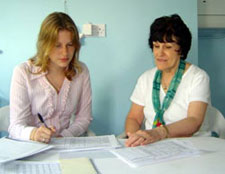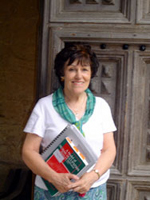Back to all Practitioner Perspectives
Dalleen Last, Clinical Specialist in Occupational Therapy, Dip. (COT UK)
Oxford City Learning Disability Team, Oxford Learning Disability Trust
As a practicing
Occupational Therapist for many years at first in Mental Health Hospitals
and now with a Learning Disability Team, I have seen several models of
practice used by clinicians. Although I have looked at and tried several,
I have remained consistently reliant on the Model of Human Occupation
(MOHO). MOHO gave me the theoretical framework for understanding where
a person's needs were and for planning the appropriate therapeutic interventions
working in the field of learning disability.
However, it was only later
that I started to use some of the assessment tools developed based on
MOHO. At a workshop in Cardiff in 1998, Gary Keilhofner introduced the Occupational
Self-Assessment (OSA) that
was then being developed by the MOHO Clearinghouse and other clinicians.
We were offered the opportunity to be involved in this development by
trying out the assessment in our work places and giving feedback on it.
I see the OSA as a tool ahead of its time. It reflects the kind of person-centred
vision found later in the 2001 the Government Learning Disability White
Paper Valuing People. In addition, the OSA supports our organization's
mission:
The Oxfordshire Learning Disability Trust
is fully committed to a person-centred approach, placing the individual
at the centre of all activities. It also aims to involve people who have
a learning disability in their community and ensure that they lead as
independent a life as possible.
The OSA has proved to be
the most valuable tool when working with learning disabled clients.
It gives clients ownership and knowledge over their experiences. I see
the OSA as a valuable tool for anyone who has not had the opportunity
to develop the occupational life that they would wish for due to societal
attitudes (e.g., towards people with learning disabilities), illness/accident,
or natural aging process. I have used the OSA many times and each time
the completion has increased people's self-confidence.
Recently I have used the OSA with a parent
who has to attend regular local authority reviews to monitor the well being of the children, which
can be a very daunting prospect. This 28-year-old parent with a mild
learning disability is currently using the OSA to demonstrate their management
of life changes. After completing the self-assessment this client could
clearly articulate the level of her daily living skills, the level of
importance that these activities are to her, and the changes that she
wished to achieve in her life. She feels totally controlled by external
agencies. However, she now views the OSA as a way of moving some of the
control back to her. When meeting with the Learning Disability interdisciplinary
team members (community nurse, community support worker and occupational
therapist) she handed out copies of the OSA and her goals and strategies
as documentation of her ability to decide the life changes she wanted
to make and to demonstrate the support that is in place to help meet
these objectives. At the end of the meeting, her OSA and related objectives
were put in the main file by the team chairperson with everyone else's
report at the meeting. It was agreed that she will repeat a self-administration
of the OSA prior to each meeting and scores from each OSA will be used
to document change and goal attainment. The Learning Disability team
agreed to base their intervention plans on the objectives established
by this client through the use of the OSA.

The Occupational Performance History Interview (OPHI-II)
proved very valuable when I was working with two young men to assess their living
skills in preparation for their move to share a house together. One person
was moving for the first time from his family home, and the other was
leaving a supported hostel. This was a significant change for the young
men, as there would be some staff support but support would not available
24 hours. The identification of a critical life incident and the narrative
slope generated through the OPHI-II gave direction to the Care Manager
as to the type of accommodation which would be most successful and the
times when support would be needed.
Other assessment tools that have been helpful for
people with a mild – moderate
learning disability have been the Assessment of Communication
and Interaction Skills (ACIS) and Volitional Questionnaire
(VQ).
Recently I worked with
a couple, both people with learning disabilities, who needed assistance
in handling benefits, debts and housing problems. It was necessary to
carefully examine the situation and propose an intervention within OT's
professional realm. After looking at each person's volition, habituation
and performance capacity, it became clear that the couple had never been
able to make their own wishes known because they felt that they would
not be acknowledged and that authorities would make their own decisions
about their lives. This influenced their volition, more specifically,
their sense of self-efficacy. Habits were also affected, as when they
got into difficulties they were used to having the issues resolved by
authorities. Their social network (which they valued) also followed the
same pattern of ‘taking over’, so they had little incentive
to be involved in the management of their own affairs. Helping
them problem solve ways of dealing with difficult situations would keep
them in control of their situation and experiences. I also needed to
assist them in finding ways of avoiding such difficulties in future while
ensuring access to additional support if needed. This challenged the
negative image that they had of themselves and changed their past routine
of having others resolve their problems. Using MOHO to guide my work
with this couple enabled us to find the right combination for the success
in both their current situation and in the future.

As practicing occupational therapists, it was very rewarding for me
to be able to bridge research and current practice Because of the strong
research evidence associated with MOHO and its assessment tools, I have
been promoting this model. I am involved in networking with other occupational
therapists in other contexts. (e.g. a renal unit and daycentres for older
people) to support their use of MOHO.
My belief and hope is that other occupational therapists will find that
using MOHO based assessment tools will:
- Be helpful in their practice
- Allow them to enhance the image of occupational therapy in the eyes of other professionals and authorities
- Achieve a person-centered approach
- and Answer the evidence-based call for clinicians to use sound outcome measures in their work